http://www.toponlinecolleges.com/blog/2011/8-plant-species-in-danger-of-disappearing/
Plants don't get enough credit in our world. They're seen as lifeless decorations or a way to recycle cow manure. But plants have a magic all their own. A bouquet of flowers can patch up a couple after a fight, while a man-eating plant can play the villain in a movie or musical. Plus, they fill that minorly important role of producing food and oxygen. So while they help keep us alive, here are eight plant species that could probably use our help to survive.
1. Hawaiian gardenia
This smal
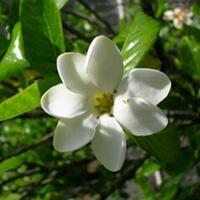 l tree with white flowers is found on the islands of Lanai and Oahu in Hawaii and is also known as Nanu, though it probably has nothing to do with Mork. The trees grow to about 16 feet tall with shiny oval leaves, and the flowers have six petals. You've probably seen the flowers, or one of the other two types of gardenias in Hawaii, used in leis. There are thought to only be 15 or 20 trees left today, and those numbers are decreasing. Once common and found on all the main islands, the Hawaiian gardenia was used by Hawaiians for wood, dyes, and landscaping purposes.
l tree with white flowers is found on the islands of Lanai and Oahu in Hawaii and is also known as Nanu, though it probably has nothing to do with Mork. The trees grow to about 16 feet tall with shiny oval leaves, and the flowers have six petals. You've probably seen the flowers, or one of the other two types of gardenias in Hawaii, used in leis. There are thought to only be 15 or 20 trees left today, and those numbers are decreasing. Once common and found on all the main islands, the Hawaiian gardenia was used by Hawaiians for wood, dyes, and landscaping purposes.
2. Poke-me-boy
Though its name sounds like a Facebook come-on, the poke-me-boy is actually a spiny tree in the bean family
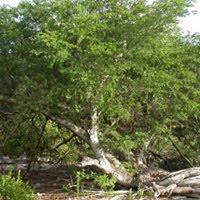 found only on the British Virgin Islands, specifically on the island of Anegada. It produces fuzzy, yellow flowers between its long thorns. As the poke-me-boy's tiny island habitat becomes more developed for residences and tourism, the plant is suffering quick losses. Fire is often used to clear land, and the trees are continuously under threat of natural disasters. Hurricanes, earthquakes, and floods threaten the poke-me-boys, which live barely above sea level. There are also many roaming animals on the one-town island that often trample or graze on the plant
found only on the British Virgin Islands, specifically on the island of Anegada. It produces fuzzy, yellow flowers between its long thorns. As the poke-me-boy's tiny island habitat becomes more developed for residences and tourism, the plant is suffering quick losses. Fire is often used to clear land, and the trees are continuously under threat of natural disasters. Hurricanes, earthquakes, and floods threaten the poke-me-boys, which live barely above sea level. There are also many roaming animals on the one-town island that often trample or graze on the plant
3. Cabbage on a stick
Cabbage on a st
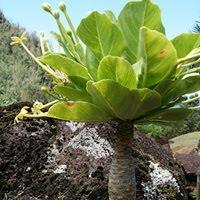 ick is pretty much what it sounds like: a tuft of leaves that looks like a head of cabbage sitting on top of a thick stick. It's also known as alula. In the wild, this plant is only found on the Hawaiian island of Kauai and without the work of botanists, it would be extinct. Because the only insect that could pollinate the cabbage on a stick, a type of hawk moth, doesn't exist anymore, the plant species can only reproduce if humans hand-pollinate it. Botanists repelled down cliffs to reach the existing alula, pollinate it, and bring some back with them to grow in nurseries. Cabbage on a stick is still critically endangered in the wild, but can be found in plant conservatories around the world.
ick is pretty much what it sounds like: a tuft of leaves that looks like a head of cabbage sitting on top of a thick stick. It's also known as alula. In the wild, this plant is only found on the Hawaiian island of Kauai and without the work of botanists, it would be extinct. Because the only insect that could pollinate the cabbage on a stick, a type of hawk moth, doesn't exist anymore, the plant species can only reproduce if humans hand-pollinate it. Botanists repelled down cliffs to reach the existing alula, pollinate it, and bring some back with them to grow in nurseries. Cabbage on a stick is still critically endangered in the wild, but can be found in plant conservatories around the world.
4. Mun ebony
Mun, or moon,
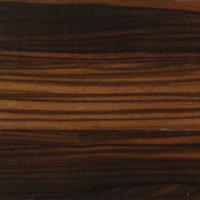 ebony is from the same family as the black, shiny stuff that goes so well with ivory in song. But mun ebony is often striped and even more rare than black ebony. It's found in Vietnam and possibly Laos, and is just as dense as its famous cousin. Because of its heaviness and fine texture that allows it to be polished, it has been very popular to make instruments, tools, and sculptures from it. The export of mun ebony is now banned, and some parks are protecting the ebony within them, but it may not be enough to keep ebony from disappearing into the hands of merchants and woodworkers
ebony is from the same family as the black, shiny stuff that goes so well with ivory in song. But mun ebony is often striped and even more rare than black ebony. It's found in Vietnam and possibly Laos, and is just as dense as its famous cousin. Because of its heaviness and fine texture that allows it to be polished, it has been very popular to make instruments, tools, and sculptures from it. The export of mun ebony is now banned, and some parks are protecting the ebony within them, but it may not be enough to keep ebony from disappearing into the hands of merchants and woodworkers
5. Golden barrel
This plant is also known as mother-in-law's cushion, which would be sweet except that the golden barrel is a c
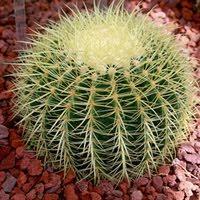 actus. Even though this prickly sphere is one of the most popular kinds of cacti in cultivation, it is nearing extinction in the wild. It's found in Central Mexico, but its habitat was severely reduced in the '90s by the construction of a dam and reservoir. The golden barrel cactus is grown all over the world in nurseries, but people continue to take the cacti illegally from the wild. Experts estimate that this plant could be extinct in the wild within 30 years. And once it's gone, where will the in-laws sit?
actus. Even though this prickly sphere is one of the most popular kinds of cacti in cultivation, it is nearing extinction in the wild. It's found in Central Mexico, but its habitat was severely reduced in the '90s by the construction of a dam and reservoir. The golden barrel cactus is grown all over the world in nurseries, but people continue to take the cacti illegally from the wild. Experts estimate that this plant could be extinct in the wild within 30 years. And once it's gone, where will the in-laws sit?
6. Virginia round-leaf birch
This birch, the most endangered tree in North America, has already come back from the dead once. After it was
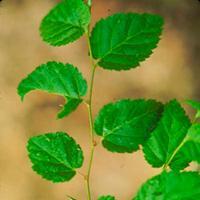 first discovered in 1918, experts thought it had become extinct when they couldn't find any more, until more birches were discovered in 1975. The tree is found in Virginia, and while there are more than 900 found in the wild as of 2006, this birch is only known to have naturally reproduced once, in the '80s. This means the round-leaf birch is dependent on human aid to keep the species going. And humans are also a major threat to the tree; vandals and thieves have historically been attracted to the trees and seedlings, presumably because of their rarity. This is why we can't have nice things.
first discovered in 1918, experts thought it had become extinct when they couldn't find any more, until more birches were discovered in 1975. The tree is found in Virginia, and while there are more than 900 found in the wild as of 2006, this birch is only known to have naturally reproduced once, in the '80s. This means the round-leaf birch is dependent on human aid to keep the species going. And humans are also a major threat to the tree; vandals and thieves have historically been attracted to the trees and seedlings, presumably because of their rarity. This is why we can't have nice things.
7. Large-leaved pitcher plant
When you first see the large-leaved pitcher plant, you might think it's just a vase of water conveniently growing in the jungle. But get too close and it could eat you — well, if you're a bug. The pitcher plant is
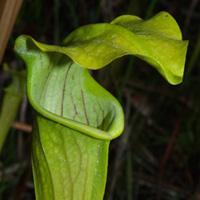 one kind of carnivorous plant, and this is one of the largest versions, with the pitcher often growing more than a foot deep. It's only found on one mountain in Borneo, though, so this species faces the threat of extinction. Pitcher plants lure insects into their fluid-filled pitchers, where the insects drown and are ingested. Large-leaved pitcher plants were recently found to have the exact dimensions as tree shrews in the area, but even though the plants probably could trap and kill the rodents, it's more likely that they are engineered to catch the shrew's droppings for food. It'd be a pity to lose one of the only plants that gathers its own fertilizer.
one kind of carnivorous plant, and this is one of the largest versions, with the pitcher often growing more than a foot deep. It's only found on one mountain in Borneo, though, so this species faces the threat of extinction. Pitcher plants lure insects into their fluid-filled pitchers, where the insects drown and are ingested. Large-leaved pitcher plants were recently found to have the exact dimensions as tree shrews in the area, but even though the plants probably could trap and kill the rodents, it's more likely that they are engineered to catch the shrew's droppings for food. It'd be a pity to lose one of the only plants that gathers its own fertilizer.
8. Capa rose
The capa rose by any other name would probably not seem like a rose at all. It's actually part of a family of smal
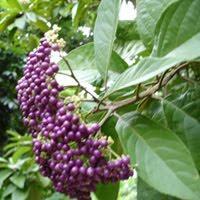 l trees that produce small, star-shaped flowers and bright purple berries. It only grows in Puerto Rico and has trouble reproducing naturally. Deforestation and development of land for agriculture are causing its habitat to shrink even further. The capa rose's habitat is under U.S. jurisdiction, and the Forest Service chose not to list its habitat as critical because they would have to publish details on the plant's location, basically providing a map for people who want to collect the plant illegally.
l trees that produce small, star-shaped flowers and bright purple berries. It only grows in Puerto Rico and has trouble reproducing naturally. Deforestation and development of land for agriculture are causing its habitat to shrink even further. The capa rose's habitat is under U.S. jurisdiction, and the Forest Service chose not to list its habitat as critical because they would have to publish details on the plant's location, basically providing a map for people who want to collect the plant illegally.
